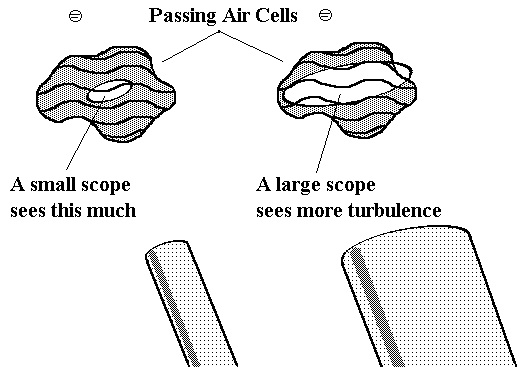Fair Air for Observing
Jack Kramer
When is the best time to observe? What time of year is best? With the weather being so unstable around here, the answer is probably "Any time the sky is clear!"
Crisp, cold nights appear to be dark and clear, but sometimes there's a lot of instability. After the passage of any cool front, at any time of year, the skies are usually pretty transparent. It seems to me that the clearest, most stable nights occur in the spring and fall. On the other hand, the sultry, hazy nights of summer may not seem so clear, but to planetary observers they're highly regarded for their steadiness. Often, a night that seems very clear (transparent) is fine for deep sky objects, but if you swing your scope over to look at a planet, you'll find the image swimming around. If you de-focus the image to a large blob, you'll see it weaving and bobbing like a punch-drunk boxer!
Experts suggest avoiding the night immediately after a weather front has passed because of turbulence that trails behind the front. Yet one of the clearest, steadiest nights I can recall occurred several years ago within a few hours after a cloudy, grey sky dissipated. Okay, let's agree that you can't always pick the best night for your observing. Is there a way to tip the odds of good observing in your favor? Here are some ideas.
Don't aim your telescope over rooftops. It may not always be possible to avoid looking over buildings, but try to avoid this. At night, roofs radiate heat accumulated during the day and emit heat waves well up into the air, causing severe instability. This is true even in winter. On top of that, belching chimneys add to the warm air above houses.
Set up your scope on the lawn. Observing from a concrete sidewalk or driveway is about as troublesome as looking over rooftops - radiated heat causes all kinds of turbulence. Observe over ground covered with vegetation, staying as far as possible from concrete, asphalt, or even gravel.
Take the high ground. If the terrain is hilly and you have an option, observe from a higher area. Cooler air and humidity tend to settle into lower levels. This contributes not only to the unsteadiness, but also to humidity, which can be even more of a problem when it fogs up your optics.
Let your optics reach ambient temperature. The mirror or lens in your telescope temporarily creates its own unsteadiness when it's at a substantially different temperature than the surrounding air. The optics expand or contract; until they settle down, the image is impossible to focus sharply. A newtonian telescope with a mirror of eight inches will take at least a half hour to settle down if there's a significant difference between the temperatures of the mirror and outside air. Until the optics settle down, a de-focused image looks very much as though its affected by atmospheric unsteadiness.
Use a small telescope to compensate for atmospherics. It may seem a wanton excess to own more than one telescope, but many of us have both large and small telescopes. While one reason for doing so is the convenience of handling a smaller scope, another advantage is the flexibility of having an instrument to use when conditions aren't very good and we need an "astronomy fix". A large telescope is looking through a large column of air; all that turbulence is brought to a focus in your eyepiece. That's why as observatory telescopes became larger, it was necessary to locate them on mountaintops above as much of the atmosphere as possible. A smaller scope sees a smaller slice of the atmosphere. The following illustration is an over-simplification, but it helps to show what's happening.

Another virtue of the small instrument is that it gathers less of the skyglow - light pollution - that lowers the contrast between the object we're observing and the sky background. It is contrast that lets us see an object in the first place, then to see detail once the object is acquired in the eyepiece. A layer of haze in the air may steady the image, but unfortunately it also accentuates light pollution. The greater light gathering and resolution of a large scope may compensate for the drawbacks, but on a night of marginal seeing, I find that a smaller instrument presents a more satisfying view, especially for planetary observing.
Observe for a prolonged period. Experienced observers know that you can't take a quick look at something and see everything you can possibly see. You have to watch an object for awhile. Most objects become sharper or obscured for varying durations as cells (those amoeba-shaped things in the drawing) pass by in the atmosphere. The durations may be from a few seconds to several minutes at a time. Even on a night when atmospheric conditions are good, there may be moments when the view becomes even better. Diehard planetary observers, in particular, usually observe an object for at least a half hour to see all that can be seen. Some observe the same object over a span of several hours, counting on those moments of perfect seeing to record the most minute of details. Also, general atmospheric conditions may change for the better (or worse) over the course of a night.
The atmosphere is something over which we have no control. But when you have the yen and the night is clear, who cares!
Published in the March 1995 issue of the NightTimes




